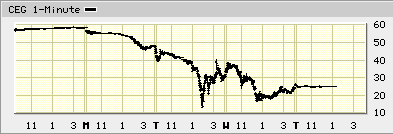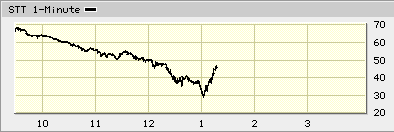The SEC's 10-day ban on the short selling of financial stocks will undoubtedly spark a great debate on Wall Street, and the merits of the rule should be discussed, but let's be honest, the government had to do something.
Morgan Stanley (MS) reported blow out earnings and a book value of $31 per share this week (a day earlier than planned, due to a sinking stock price) and the stock reacted by dropping 60% from $30 to $12 per share. Another day or two of that and the firm could have filed bankruptcy (and Goldman Sachs probably would have followed), even though it earned $1.43 billion on $8.0 billion in revenue for the quarter ended August 31st.
State Street (STT) drops from $68 to $29 yesterday on no news. The company issues a press release saying nothing is wrong and the stock recovers.
These are not stories of orderly markets that are functioning normally. If not this SEC ban, then what else should they have done to restore order? What are the alternatives?
When traders can have that much impact on a company's fate because falling share prices for no fundamental reason can lead to bankruptcy within days, or the need to sell your company for a bargain basement price because you have no other choice, that is not an orderly market. It's that kind of thing that causes panic and could create a 1987-like crash, or worse, a 1929 depression-like crash. If based on fundamentals, those events, while dire, are not something we should prevent. However, the events of this week were not based on fundamentals, they were based on speculators, false rumors, and panic.
I have no problem with short selling. But when unrelenting shorting can contribute to a company falling into a death spiral, a company that otherwise would have easily avoided such fate, I really don't have a problem with banning shorting for 10 days to make sure our market can function normally.
If short sellers and/or hedge funds want to bet against these firms, all they have to do over the next 10 days is buy puts. If their fundamental analysis is correct, they'll make a killing from those bets. But those bearish bets should not directly contribute to the demise of our country's largest financial institutions. Just because Bear Stearns and Lehman Brothers were bad investment banks, Morgan Stanley and Goldman Sachs should not be forced to fail too when they have managed their risks far better and are still in the black to the tune of billions of dollars.
Full Disclosure: No positions in the companies mentioned at the time of writing
UPDATE 9/19 3:35PM ET
Lots of reporting in the media that the rally today is due to short covering because of the new short selling rules. This is nonsense. The rule bans shorting of financials starting today. It does not force previous shorts to be covered. Not only that, if you short stocks and you know you won't be able to make new shorts for the next 10 trading sessions, and the Dow soared 400 at the open today, why would you cover your existing shorts? If you really believed in your negative view of the stocks, and the prices went up at a time when you were banned from shorting more shares, you would certainly keep the shorts on rather than covering them. -CB



